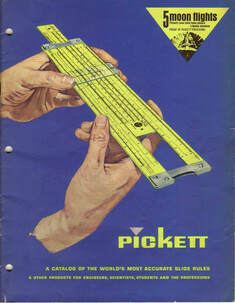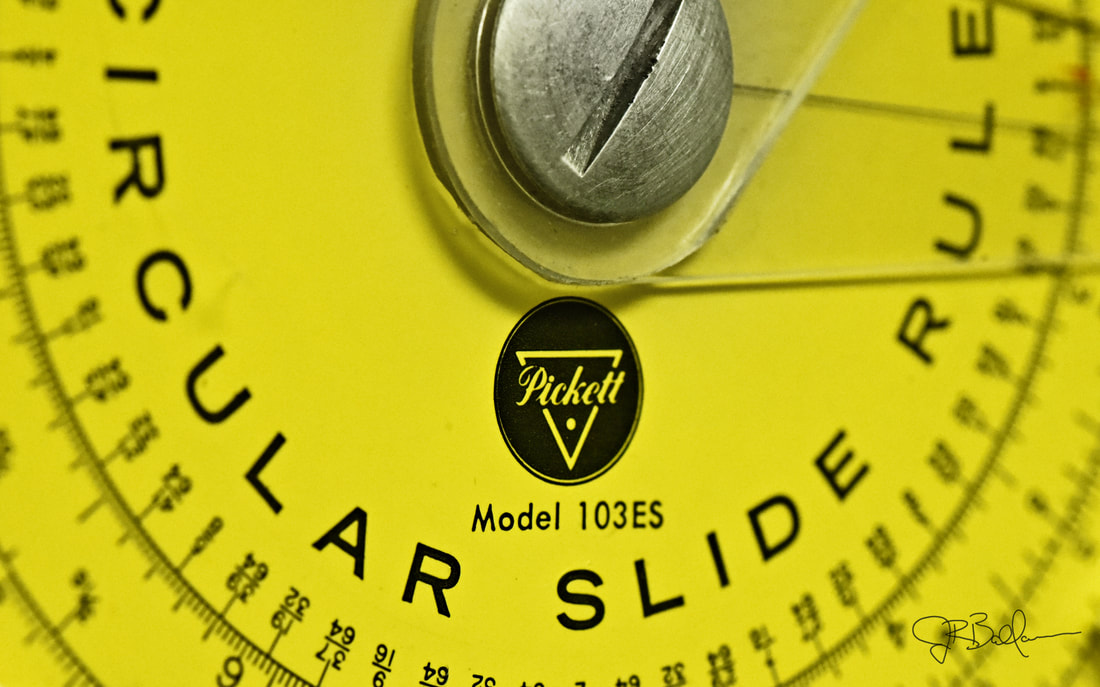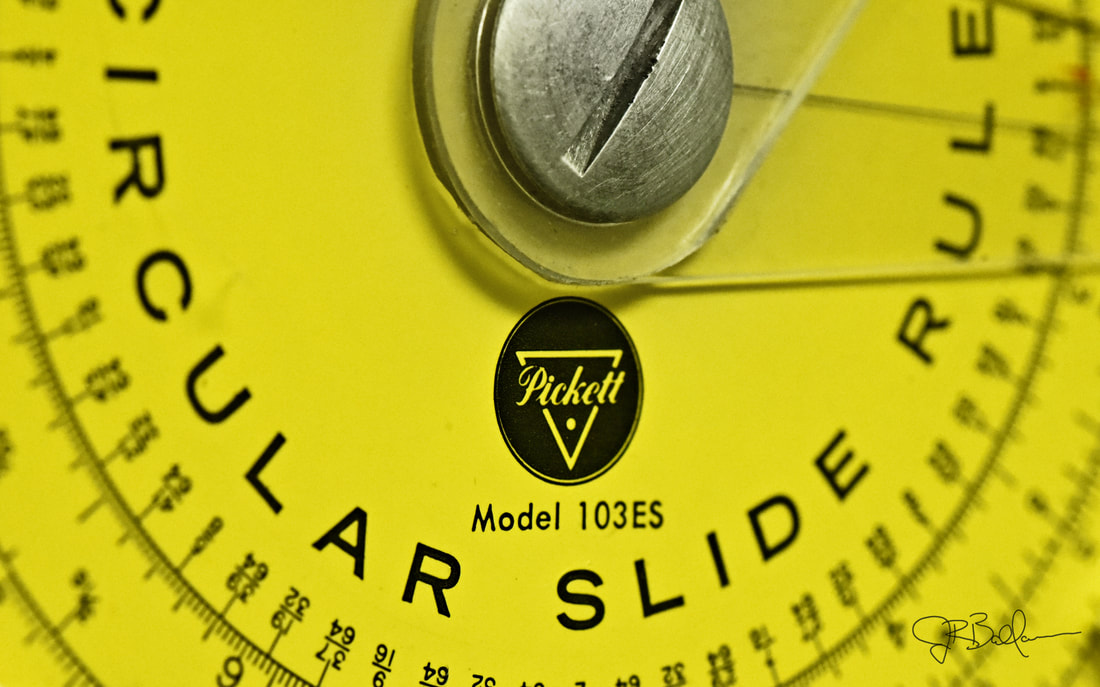Furthermore, if the same rule went through refinements or enhancements without necessitating a new model, then Pickett would designate this "new" version of the rule by use of "N" before the number. As such, the N4-ES slide rule was preceded by the "Model 4-ES." For the most part, non-N varieties are the magnesium predecessors. However, some of the product lines had a transitional model, often made of thicker aluminum, around 1950. But at some point shortly thereafter, Pickett settled on standardized thickness for their aluminum rules, which is remarkably consistent over the company's last 25 years or so.
Most Pickett low-budget rules and their lower-cost aluminum rules included a plain plastic slip case and "how to use" instruction booklet. The powerful (expensive) rules. as well as many of the specialty rules, gave buyers an upgrade to a nice leather case.
In the 60s and 70s, Pickett did shift most of their student slide-rules to plastic. These are good slide rules, but are rather unremarkable. These rules typically have model numbers between 115 to 160. As a high school Precalculus teacher, I give many of these rules to my own students today to encourage further investigations, having first earned them by doing an extra-credit research project.
To be certain, I find the typical aluminum Pickett rule to be less enjoyable to use than competitor rules made of wood or high-grade plastic. They feel cold in my hand and I find them somewhat hard to read, which is an emotion found among many collectors. The lithographic type also doesn't endure as well over time and with regular usage, as many samples will be faded or rubbed-away.
Pickett was widely known for producing a variety of custom slide rules for a variety of clients. As such, there is a remarkable array of "specialty" rules that can be found which, in my mind, is the best part about collecting Pickett rules today. This is made possible because almost every metallic rule is the same, except for what is printed on the rule. As such, once the photographic master is created, any number of rules can be quickly and cheaply printed. So if a client wanted a custom-rule made, Pickett could do in a short run of such a rule without too much extra expense. In my collection, we will see that most of the larger custom rules like this, particularly the ones with the most value today, will be found within the range of rules between models 5 and 19. A collection with most or ALL of those models will be truly outstanding.
Dating Pickett rules is also difficult to accomplish, as they did not change their rules at all over extended periods (typically 4 to 8 years), nor did they use serial numbers. The best we can do is to identify a slide rule to one of maybe seven distinct eras of the company based on changes to the Pickett logo (on the rule) as well as the evolution of slide rule construction and materials. Likewise, the designs of the cursors and end-brackets over time can yield amount of enlightenment. As such, I will date them between a certain range of years based on these features.
But the sheer number of Pickett rules and the stories they tell really make them one of my favorite slide rule brands to collect. I have some Pickett rules that nobody else seems to possess, even among the most avid collectors today. I find stumbling across such treasures to be very satisfying.
Most Pickett low-budget rules and their lower-cost aluminum rules included a plain plastic slip case and "how to use" instruction booklet. The powerful (expensive) rules. as well as many of the specialty rules, gave buyers an upgrade to a nice leather case.
In the 60s and 70s, Pickett did shift most of their student slide-rules to plastic. These are good slide rules, but are rather unremarkable. These rules typically have model numbers between 115 to 160. As a high school Precalculus teacher, I give many of these rules to my own students today to encourage further investigations, having first earned them by doing an extra-credit research project.
To be certain, I find the typical aluminum Pickett rule to be less enjoyable to use than competitor rules made of wood or high-grade plastic. They feel cold in my hand and I find them somewhat hard to read, which is an emotion found among many collectors. The lithographic type also doesn't endure as well over time and with regular usage, as many samples will be faded or rubbed-away.
Pickett was widely known for producing a variety of custom slide rules for a variety of clients. As such, there is a remarkable array of "specialty" rules that can be found which, in my mind, is the best part about collecting Pickett rules today. This is made possible because almost every metallic rule is the same, except for what is printed on the rule. As such, once the photographic master is created, any number of rules can be quickly and cheaply printed. So if a client wanted a custom-rule made, Pickett could do in a short run of such a rule without too much extra expense. In my collection, we will see that most of the larger custom rules like this, particularly the ones with the most value today, will be found within the range of rules between models 5 and 19. A collection with most or ALL of those models will be truly outstanding.
Dating Pickett rules is also difficult to accomplish, as they did not change their rules at all over extended periods (typically 4 to 8 years), nor did they use serial numbers. The best we can do is to identify a slide rule to one of maybe seven distinct eras of the company based on changes to the Pickett logo (on the rule) as well as the evolution of slide rule construction and materials. Likewise, the designs of the cursors and end-brackets over time can yield amount of enlightenment. As such, I will date them between a certain range of years based on these features.
But the sheer number of Pickett rules and the stories they tell really make them one of my favorite slide rule brands to collect. I have some Pickett rules that nobody else seems to possess, even among the most avid collectors today. I find stumbling across such treasures to be very satisfying.
General-Purpose Rules |
Specialty Rules |
|
Here are Pickett slide rules that allow for basic to complex evaluation of mathematical computations and functions. I will also include "engineering" rules here, since that designation typically includes hyperbolic trig scales which, as far as I'm concerned, is still computational mathematics; however, where that applies, I will make note of that.
Expand the titles below to see pictures and specifications... Full-Scale Rules |
These Pickett slide rules are "specialty" rules because they were designed or marketed for a specific purpose in mind. Such a rule will often include one or more scales for a specific application, whether a finance formula, chemistry conversion, electronics functions, or even unit conversions.
Expand the titles below to see pictures and specifications... Full-Scale Rules |
|
N4-T Vector hyperbolic Dual Base log log
Vector Type Log Log Dual Base Scale Length: 10" Purpose: Engineering/Hyperbolic Trig/Vector # of Scales: 34 Country: USA Material: Aluminum Date: 1958 to 1962 Condition: C4 (like new, but with case only) Front Side Scales 3√ #1, 3√ #2, 3√ #3, DF [ CF, CIF, T1, T2, ST, S Cos, CI, C ] D, DI, √ #1, √#2 Rear Side Scales LL1+.00D/-.00D, LL2+.0D/-.0D, DF/m [ CF/m, TH, SH, Ln, L, CI, C ] D, LL3+.D/-.D, LL4+D./-D n4-ES Vector dual Base Log Log
N3-ES Power log Exponential
N500-ES hi-log log duplex
N902-ES SImplex trig
Model 1000 ortho-phase Duplex
N1010-ES Trig Duplex
N1010LS-ES SUper power trig
Model 2 Deci Log Log Duplex
MOdel 902 Simplex trig
N1010-T Trig duplex
N901-ES Simplex
N903-ES Trig and Conversion
N909-ES Simplex Trig with Metric Conversion
Model 4 Vector Hyperbolic Deci Log Log
Model 800 log log duplex
Pickett B1 Bamboo rule
Pocket RulesN600-ES log log duplex
N300-T log log duplex
N200-T Trig
N1006-ES Duplex trig
Model 20 Basic
N4P-ES vector-type log log duplex
Circular Rules111-ES Circular
Model 101-C DIal-rule CirculaR
110-ES Circular
108-ES Circular
|
Model 14 US Military
N16-ES Electronics
C19-T Collins Microwave transmissions
N525-ES Stat-Rule
N531-ES Capital Radio Engineering Institute
N535-ES Electronic technician
N808-T Standard Marine Fuels
N1041-Gp Universal Valve Sizing
N1072-ES Spring Calculator
N905-ES Texas Slide Rule
Model 575 Kellogg Hydraulic rule
N1041-G Fisher Controls Universal Value sizing
Model 6-T Statistical Quality Control Rule
N15-T Georgia Ironworks Hydraulic rule
Pr-12 Projection slide rule
PR-13 LOg LOG Projection Slide rule
N515-T Cleveland Institute of electronics rule
N1080-ES & N1080-T Refinery Supply Co. Calculator
N1090-ES Connor spring Manufactoring calculator
Pocket RulesModel 100 Douglas Sky rule
Made in USA for Douglas Aircraft - 1952 Scale Length: 5" Purpose: Aeronautic Engineering # of Scales: 16 Country: USA Material: Aluminum Date: 1952 Condition: C3 (like new with case) Front Side Scales Dynamic Pres., Temp Rise [ Static Pres., Pres. Alt, Density Alt., C ] D, True Mach. TAIS Rear Side Scales Impact Pres., Std. Temp., Pres. Alt. [ Temp. Venier, Pres. Alt. ] True Mach No., Dial Airspeed. ] Blank Model 700 Aerial Photo USAF
Model 400 Business
Circular Rules103-ES mark-up
106c proportional scale
105-c Profit rule
112C Metric Convertor Scale
|











